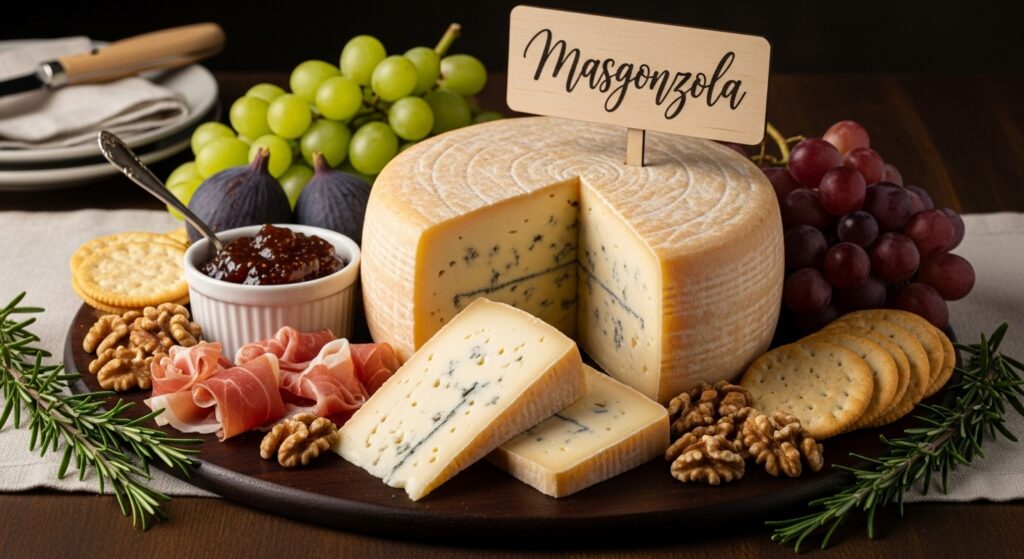Masgonzola is a fascinating cheese hybrid that merges the smooth, rich texture of mascarpone with the tangy, sharp taste of gorgonzola. This innovative creation, known as Masgonzola, captures the best of both worlds — the creaminess of Italian desserts and the savory punch of blue cheese. From gourmet dishes to casual spreads, this cheese has earned a growing reputation among chefs and food enthusiasts worldwide.
In the world of fine dining and culinary creativity, Masgonzola stands as a symbol of flavor harmony, offering a balance that satisfies both sweet and savory cravings.
The Origin of Masgonzola
The concept of combining mascarpone and gorgonzola likely originated in Italy, where both cheeses hold deep cultural significance. Mascarpone, a soft, mild cheese from the Lombardy region, is celebrated for its use in desserts like tiramisu. Gorgonzola, on the other hand, brings a distinctive blue-veined character and tang that appeals to strong cheese lovers.
When these two are blended, Masgonzola is born — a creamy blue cheese that is milder and more versatile than traditional gorgonzola. Its subtle sweetness and buttery finish make it ideal for sauces, dips, and even desserts.
Texture and Flavor Profile of Masgonzola
The unique quality of Masgonzola lies in its perfect textural and flavor balance. It delivers a rich, velvety mouthfeel that melts beautifully on the tongue while offering a mild blue cheese tang that never overwhelms.
| Characteristic | Mascarpone | Gorgonzola | Masgonzola (Fusion) |
|---|---|---|---|
| Texture | Soft and creamy | Crumbly and veined | Smooth, semi-soft |
| Flavor | Sweet and buttery | Tangy and salty | Mildly tangy, creamy |
| Use | Desserts | Salads, sauces | Savory & sweet dishes |
| Origin | Lombardy, Italy | Northern Italy | Modern Italian fusion |
This combination creates a cheese that is both familiar and novel, making Masgonzola a favorite among those who appreciate depth and sophistication in their food.
Culinary Uses of Masgonzola
Masgonzola’s versatility in the kitchen is what makes it stand out. It can replace traditional blue cheese or mascarpone in recipes, depending on the flavor intensity desired. Chefs love it for its ability to melt smoothly and enrich dishes without overpowering other ingredients.
Masgonzola in Savory Dishes
When it comes to savory meals, Masgonzola works wonders:
-
Pasta sauces – A spoonful of Masgonzola adds creaminess and flavor depth to Alfredo or carbonara.
-
Risottos – Blending Masgonzola into risotto gives it a smooth, rich texture with a subtle tang.
-
Pizza toppings – Combined with caramelized onions or prosciutto, it elevates any pizza to gourmet status.
-
Steak sauces – Its creamy base complements the robust flavor of grilled meats.
Masgonzola in Sweet Dishes
Surprisingly, Masgonzola can also shine in desserts:
-
Cheesecakes – Adds complexity to traditional mascarpone cheesecakes.
-
Fruit pairings – Perfect with figs, pears, or honey for a luxurious treat.
-
Pastry fillings – Blended with cream and sugar, it makes a luscious pastry filling.
Nutritional Value of Masgonzola
Besides its indulgent flavor, also offers nutritional benefits when consumed in moderation.
| Nutrient | Per 100g of Masgonzola |
|---|---|
| Calories | 340 kcal |
| Protein | 12 g |
| Fat | 30 g |
| Carbohydrates | 2 g |
| Calcium | 20% of RDI |
| Sodium | 550 mg |
While it’s rich in fat and calories, the high calcium and protein content make it a nourishing addition to a balanced diet.
The Making of Masgonzola
Creating involves precise craftsmanship. The process combines equal parts of mascarpone and gorgonzola under controlled temperatures to achieve the ideal consistency and flavor.
Step-by-Step Overview:
-
Selection of Cheeses: Fresh mascarpone and aged gorgonzola are chosen for balance.
-
Blending Process: Both are gently mixed to retain texture and prevent separation.
-
Aging Period: The mixture is aged briefly to allow the flavors to marry without intensifying the blue mold too much.
-
Packaging: Once the texture is smooth and spreadable, it’s packaged for sale or culinary use.
This delicate process ensures that remains creamy while preserving the character of blue cheese.
Pairings and Serving Suggestions for Masgonzola
Pairing properly can enhance its distinct qualities. Here are some perfect combinations:
| Food or Drink | Pairing Reason |
|---|---|
| Crackers or Crostini | Highlights its creaminess |
| Fresh figs or pears | Balances salt with natural sweetness |
| Red wines (Merlot, Chianti) | Complements tangy undertones |
| Honey drizzle | Adds contrast to the blue cheese note |
| Walnuts or almonds | Enhances texture and nuttiness |
These pairings make a great choice for cheese boards, appetizers, or elegant desserts.
Why Masgonzola Is Gaining Popularity
The rise of Masgonzola reflects modern food trends that celebrate fusion and innovation. Consumers today seek bold flavors without compromising on texture or balance. offers precisely that — a cheese that feels indulgent yet approachable.
Its adaptability to both sweet and savory cuisines makes it ideal for restaurants, home cooks, and food bloggers. Moreover, its intriguing story of blending two iconic Italian cheeses appeals to gourmet audiences worldwide.
How to Store Masgonzola
To preserve the quality of , it should be stored properly:
-
Temperature: Keep it refrigerated between 2°C and 6°C.
-
Packaging: Wrap it in wax paper, then seal in an airtight container.
-
Shelf Life: Best consumed within 7–10 days after opening.
Avoid freezing, as it may alter its creamy consistency and flavor profile.
Comparison Between Masgonzola and Other Cheeses
Here’s how compares with popular alternatives:
| Cheese Type | Texture | Flavor | Ideal For |
|---|---|---|---|
| Brie | Soft-ripened | Mild and buttery | Appetizers |
| Blue Cheese | Crumbly | Strong and salty | Salads and sauces |
| Mascarpone | Velvety | Sweet and creamy | Desserts |
| Masgonzola | Semi-soft | Mildly tangy and creamy | Both savory and sweet dishes |
As seen above, combines the best aspects of several cheese types, making it one of the most versatile options available.
The Future of Masgonzola
As food innovation continues, Masgonzola may become a staple in both home kitchens and fine dining establishments. Its fusion appeal opens new doors for experimentation — from -filled pastas to dessert spreads and gourmet sauces.
With the growing appreciation for artisanal and hybrid cheeses, the future looks bright for this creamy creation.
Conclusion
Masgonzola is more than just a blend of mascarpone and gorgonzola; it’s a testament to culinary creativity and balance. With its creamy texture, mild blue flavor, and broad versatility, it bridges the gap between sweet indulgence and savory sophistication. Whether spread on bread, melted into pasta, or paired with fruits, continues to impress both chefs and cheese lovers around the world.
In every sense, proves that innovation in the culinary world can yield extraordinary taste — one smooth, tangy bite at a time.






